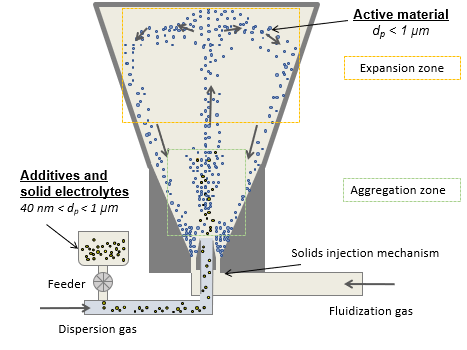Spouted bed processing for structuring of conductive battery hetero-aggregates

Project Leader :
Prof. Dr.-Ing. habil. Stefan Heinrich
Hamburg University of Technology
In this project, a novel spouted bed dry coating process will be established, which is able to fabricate hetero aggregates consisting of three materials, that are suitable for the use in all-solid-state-batteries. The materials, with primary particle sizes ranging from 40 nm to around 1 µm, will be provided within the SPP by the working group of Prof. Kwade in Braunschweig and resemble candidates for the production of high-performance batteries.
The composites will be formed inside the spouted bed by mixing the materials and creating aggregates due to the cohesive forces. The main advantage of this novel method are the avoidance of dangerous-to-health solvents, high forces acting in spouted bed processes and at the same time a scale-up potential.To be able to handle three solid streams in the spouted bed simultaneously, two new, different approaches regarding the injection of solids will be evaluated: a central nozzle-like injection and an injection together with the fluidization gas.
Therefore, an existing miniaturized spouted bed plant will be reconstructed and afterwards the first composites will be produced, which will be evaluated regarding their mechanical properties and their composition. Especially the stability of the aggregates as well as the distribution of the different materials inside the aggregate are key factors, which determine the later application in solid-state batteries. The electrochemical properties of the composites, especially the electric and ionic conductivity as well as the chemical stability will be investigated in Braunschweig.
By receiving feedback from our partners, the process parameters (e.g. solids mass flows, gas velocities and bed mass) will be changed, to achieve a fundamental understanding of the relationship between process parameters and aggregate structure and produce aggregates with the best properties for the use in all-solid-state batteries. The foundation of this work will be the evaluation and expansion of existing theoretical models for interparticular forces acting during dry coating processes. By using experimental as well simulative methods, the forces (cohesion, breakage, compression) acting on particles during a spouted bed process will be analysed experimentally as well as by simulation.
The gas flow inside the plant will be modelled by CFD to determine the velocities of the trajectories of the particles, which indicate the highest stresses acting on the particles. With this knowledge it is possible to simulate the particular interactions in DEM. Goal of this work is the ability to predict the behaviour during a dry coating spouted process by describing the microprocesses numerically. Afterwards, it will be possible to describe the process by population balances, which in turn will be used to create a theoretical model for the use in flowsheet simulations (Dyssol) and lay the foundation for further coupled CFD-DEM simulations of the process, which are planned for the second funding period.

